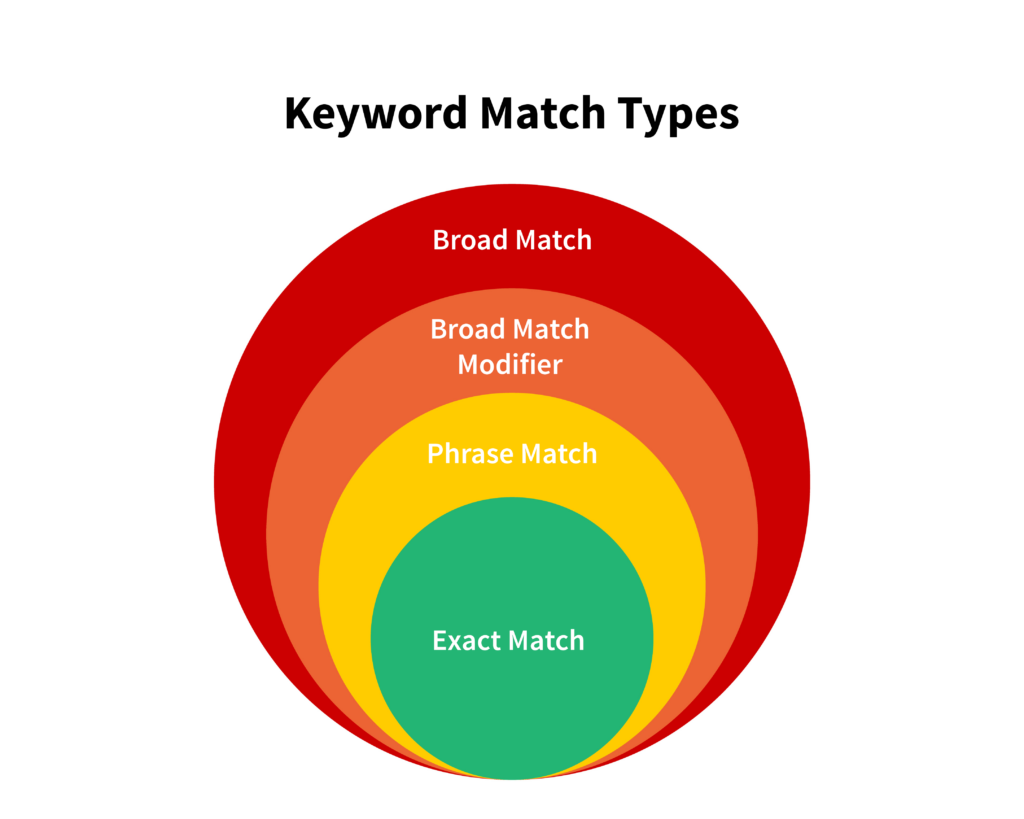In the Google Ads platform, advertisers can work with different paid search keyword match types to enhance campaigns. Each type has advantages and disadvantages, which can be very effective in the right hands. Using a suitable match type can yield higher click rates and/or conversion rates or even avoid duplicate ad servings. In the end, mastering the match types can bring your ROI to a remarkable level. This guide will explain the different keyword match types and how to use each.

Paid Search Keyword Match Types
Three different paid search types are available for use in the Google Ads platform. Below is a list of the varying types and their descriptions:
- Broad Match: Sends your ad to queries relevant to your keyword, which may or may not include the keyword itself.
- Phrase Match: Sends your ad out to queries that include the meaning of your keyword, with other words appearing before or after it.
- Exact Match: Sends your ad to queries that mean the same as your keyword, including those that do not directly contain the specified keyword.
As a Paid Search or Digital Marketing Analyst, learning about each search query and its distinct uses is important. Doing so can open up many doors for your advertising campaign and allow you to pivot when necessary.
Broad Match: High Audience Reach
As the default match type, broad matching finds the most audiences possible for your ad spend. This match type will serve your ads to search queries related to your chosen keyword, even when they do not contain the keyword itself.
To ensure that search queries are relevant to your selected keyword, Google considers the users’ search activities, the content of your designated landing page, and sister keywords in your ad group.
It is also noted that this mode is best for smart bidding.
To use broad match, simply type your keyword into the field with no extra markup. After running your campaign, your ad will be served to users querying for keywords related to your chosen keyword, which may or may not include the keyword itself.
Example: If your keyword is car battery, then the queries could be along the lines of battery meter, jumper cables, or electric vehicle.
Since this matching type attempts to find as many users as possible in every corner of the world, you could use it to build an online presence for your brand. This would bring your brand to the forefront of the internet in places where your advertisement should appear. Once users are comfortable with seeing your brand, you could take the next step and start campaigning to acquire those customers.
Phrase Match: Tailored Audience Reach
Phrase matching allows you to serve ads to user search queries that include the meaning of your keyword. It may also find keywords that are more specific than your current keyword. Other words can come before the keyword or behind the keyword but cannot reside in between.
This match type narrows down the search user pool, meaning your ads will have a smaller reach. This means that your targeting is much more precise and can help you find the exact audience you want.
To use phrase matching, type in your keyword surrounded by quotation marks.
Example: The keyword “car battery” could serve ads to users searching for car battery replacement, buy car battery on sale, or cheap car battery. It would not show ads for car dealership, or types of batteries.
If you already know your target audience, then phrase matching could help you rendezvous with them quickly. Since the search user pool is much smaller, you will only spend on the audience that comes close to what you campaigned for. Use this match type when you are ready to scale your campaigns.
Exact Match: Niche Audience Reach
Exact matching targets your ads toward search queries with the same meaning as your keyword. This will include various forms of your keyword, ranging from plurality, abbreviations, misspellings, and so on.
To use this match type, surround your keyword with brackets.
Example: The keyword [car battery] could serve ads to queries on battery car, battery for a car, or car batteries. It would not serve ads for truck batteries or replacement batteries.
This matching type serves a very small audience, which makes it best for laser-focused campaigns. If you know exactly what keywords work best for your advertisements, then this would certainly amplify your efforts. Try targeting “buyer” keywords when initiating a campaign and observing its trajectory.
Negative Keywords: Avoiding Certain Searches
Negative keywords allow you to exclude specific keywords from receiving your ad placements. Your ads will be served to relevant search terms but not to those containing the specified keywords.
Negative keyword layering is best used at the next step of a campaign. Typically, you would initiate a phrase or exact match campaign and have it run for 30-90 days. When you pull your search term report, you will get to view which ones have not worked. This is where you can add in the negative keywords so that you can stop bidding on them. This strategy allows you to optimize your campaign even further to make the most of your ad spend.
Negative keywords allow you to avoid specific audiences or situations. It’s particularly useful when your niche aligns too closely with another, and the terminology could interfere with your campaign. Or, you may already have a currently running campaign targeting that particular audience. In either case, using negative keywords can help you hone in on very specific audience segments you have not already engaged with.
That said, negative keyword layering must be combined with one of the match types to proceed with the next step of your campaign. Negative keywords can be used in the following formats:
- Negative broad match
- Negative phrase match
- Negative exact match
Learn to use them in the following sections:
Negative Broad Match
This stops your ads from appearing in search queries containing all of the selected keywords, regardless of the order of appearance.
To use this negative keyword type, type in the keyword itself. Do so in an existing exact, phrase, or broad match campaign.
Example: The keyword car battery would not serve your ads to queries for cheap car battery, battery for car, or battery jump car. It could serve ads for queries such as truck battery, jumper cables, or car not starting.
Negative Phrase Match
This type of negative keyword excludes search terms for your exact keyword phrase in the exact order presented. Queries with words before or after your keyword will not receive advertisements.
To use this match type, type in your keyword surrounded by quotation marks into an existing campaign.
Example: The keyword “car battery” will not serve your ad to search queries for cheap car battery, buy car battery, or car battery frozen. Ads could be served for automotive battery, battery for a car, or cheap vehicle batteries.
Negative Exact Match
This type of negative keyword excludes the exact search query from displaying your ads.
Use this negative keyword type for specific search queries you do not wish to engage with. Of course, you should have already done research to obtain such data beforehand.
To use this match type, type in the keyword surrounded by square brackets into an existing campaign.
Example: The keyword [car battery] would not serve your ad to queries for car battery. It could serve your ad to queries for best car battery, buy car battery, or need a battery for my car.

Match Type Cheat Sheet
The different match types have their own specifications and effects, which may seem confusing at first glance. However, after a few sessions in your Google Ads account, you should be able to pick it up and remember it rather well. To help you memorize the information, here is a small cheat sheet containing the variables:
- Broad Match: high reach/ads served on related searches
- Phrase Match: medium reach/ads served on searches that include the meaning
- Exact Match: tight reach/ads served on searches with the same meaning
- Negative Keywords: variable reach/excludes ads from the query, based on the type of keyword used and the associated match combination
Refer back to this cheat sheet as a reference whenever you need to remember the different match types with a glance.
What is the Best Keyword Matching Strategy?
Although each match type has its own purposes, experienced digital marketers will tell you that certain ones will outperform others when it comes to ROI. To maximize your efforts and ad spend, prioritize campaigns in the following order: exact match > phrase match > broad match.
- Exact matching will serve ads to users searching for your exact meaning, which means they are looking for something very specific. You can be the one to give them what they want by getting in front of them when they are ready to purchase or on the verge of doing so. The key to becoming their hero is through using exact matching to its full potential.
- Phrase matching will serve your ads to searches that include the meaning of your keyword, which means that users are seeking something involving your keyword. You could look to remind them of what they may have forgotten, or introduce them to something new that they would never have thought of on their own. This will help you capture sales and customers that would have otherwise slipped through the cracks.
- Broad matching serves your ad to searches that relate to your keyword, but may not include the keyword itself. Here, you can lay the foundation for trust in prospective customers by entering their world, one step at a time. As they become familiar with your brand, they may feel more comfortable engaging with your product or service later, possibly through one of the other keyword-matching campaigns.
- Negative keyword layering can be implemented into an existing campaign to avoid undesirable search terms. Consider using this after an initial run, which is typically 30-90 days.
While exact matching is quite powerful, it also shouldn’t be your only avenue of paid search advertising. A solid, reliable search campaign should encompass any or all of the other match types to get the best reach, engagement, and overall results possible. Additionally, your budget and goals will affect which strategies you decide to develop, so speaking to a digital marketing agency representative could help you start off strong.
Contact J&L Marketing for Custom Search Campaigns and “Be the Expert”
J&L Marketing is a direct mail and digital marketing agency serving the automotive, home services, and political industries. We know you can achieve more with Google Paid Search and want to help you navigate the Google Ads advertising platform.
We do this by walking you through the entire process and designing a custom campaign based on your needs, goals, and budget. After all is said and done, you will have your own digital marketing campaigns running with us at the helm. Click here to schedule an appointment with our responsive staff so that you can get your paid search campaign started today.



